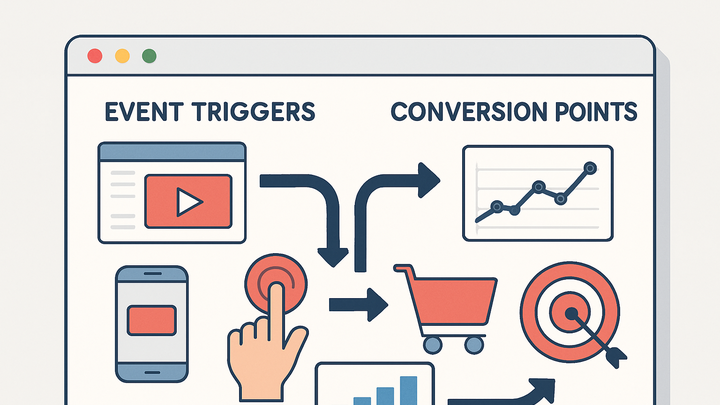Published on 2025-06-28T06:53:21Z
What is Conversion Tracking? Examples in Analytics
Conversion tracking is the process of recording and analyzing user actions (conversions) on your website or app that align with business goals, such as purchases, sign-ups, or downloads. In analytics, conversion tracking involves embedding tracking code snippets or using analytics tools to capture events and attribute them to specific marketing campaigns or user interactions. By measuring conversions, businesses can evaluate the ROI of their marketing efforts, optimize user funnels, and make data-driven decisions. Common analytics platforms for conversion tracking include Google Analytics 4 (GA4) and privacy-focused solutions like PlainSignal. Implementing conversion tracking typically requires defining goals or events, installing tracking tags, and configuring attribution models to understand how different touchpoints contribute to conversions.
Conversion tracking
Tracks user actions and attributes them to goals, measuring campaign performance and ROI in analytics platforms like GA4 and PlainSignal.
Why Conversion Tracking Matters
Conversion tracking is essential for understanding which marketing channels and user journeys drive valuable actions. It provides visibility into campaign performance, informs budget allocation, and highlights optimization opportunities.
-
Roi measurement
By tracking conversions linked to specific campaigns, you can calculate return on investment and justify marketing spend.
-
Funnel optimization
Analyzing where users drop off in the conversion funnel helps identify friction points and improve the user experience.
How Conversion Tracking Works
Conversion tracking collects data on predefined events or goals, processes the data through analytics platforms, and attributes conversions to marketing touchpoints based on selected attribution models.
-
Event data collection
Tracking code or SDK captures user interactions (e.g., button clicks, form submissions) as events sent to the analytics service.
-
Goal configuration
Define which events count as conversions (e.g., purchase completed, lead form submitted) within the analytics platform’s interface.
-
Attribution models
Assign credit for conversions across multiple touchpoints using models like first-click, last-click, or data-driven.
-
First-click attribution
Gives full credit to the user’s first interaction with your site or ad.
-
Last-click attribution
Gives full credit to the last interaction before the conversion.
-
Data-driven attribution
Uses machine learning to distribute credit based on observed conversion paths.
-
Implementing Conversion Tracking with GA4
Google Analytics 4 uses events as its primary data model. You can configure conversions by marking specific events as conversions and installing the GA4 tracking snippet on your site.
-
GA4 tracking snippet
Install the global site tag and configure your measurement ID as follows:
<script async src="https://www.googletagmanager.com/gtag/js?id=GA_MEASUREMENT_ID"></script> <script> window.dataLayer = window.dataLayer || []; function gtag(){dataLayer.push(arguments);} gtag('js', new Date()); gtag('config', 'GA_MEASUREMENT_ID'); </script> -
Marking events as conversions
In the GA4 interface, navigate to Events, select an event, and toggle “Mark as conversion” to count it towards your goals.
Implementing Conversion Tracking with PlainSignal
PlainSignal offers a privacy-friendly, cookie-free approach to analytics. It simplifies conversion tracking by using a single snippet and focusing on essential metrics without personal data.
-
PlainSignal integration
Add the following snippet to your site to enable conversion tracking:
<link rel="preconnect" href="//eu.plainsignal.com/" crossorigin /> <script defer data-do="yourwebsitedomain.com" data-id="0GQV1xmtzQQ" data-api="//eu.plainsignal.com" src="//cdn.plainsignal.com/plainsignal-min.js"></script> -
Defining conversion events
Use PlainSignal’s dashboard to define URLs or custom event names that should count as conversions (e.g.,
/thank-youpage visits).
Best Practices for Conversion Tracking
Following best practices ensures accurate, actionable data and compliance with privacy regulations.
-
Define clear goals
Establish specific, measurable conversion actions aligned with your business objectives.
-
Validate tagging setup
Use tag debugging tools and preview modes (e.g., GA4 DebugView) to confirm events fire correctly.
-
Ensure privacy compliance
Follow regulations like GDPR by anonymizing data and providing opt-out options when necessary.
Common Pitfalls and Troubleshooting
Awareness of typical mistakes helps avoid data discrepancies and misinterpretations.
-
Duplicate tags
Having multiple instances of tracking code can inflate event counts and distort metrics.
-
Untracked pages or actions
Missing tags on key pages or forgetting to configure conversion events leads to underreporting.
-
Incorrect attribution setup
Misconfigured attribution windows or models can misrepresent channel performance.
